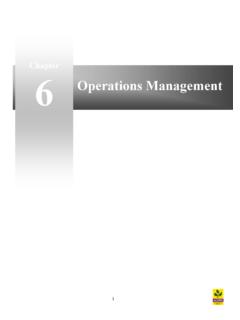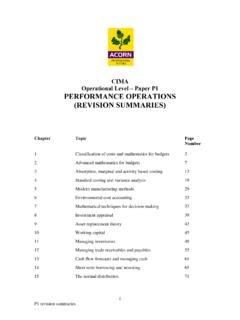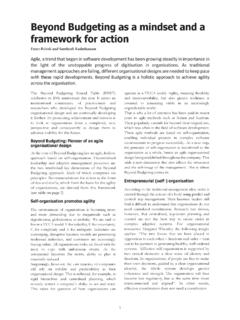Transcription of CIMA Strategic Level Paper P3 PERFORMANCE STRATEGY ...
1 1 CIMA Strategic Level Paper P3 PERFORMANCE STRATEGY ( revision summaries ) Chapter Topic Page Number 1 Management control systems 3 2 Divisionalisation and controlling people 15 3 Review and the audit process 27 4 Sampling, evidence and substantive testing 43 5 Internal controls for key cycles 51 6 Corporate governance, ethics and internal audit 57 7 What is information?
2 67 8 IS, IT and IM strategies 73 9 Information systems 77 10 Risk and control in information systems 81 11 The internet and auditing the system 87 12 Risk management 95 13 Foreign exchange risk 101 14 Interest rate risk 113 2 3 Management control systems Chapter 1 4 Hierarchy (scalar chain) and span of control Scalar chain (hierarchy) chain of command Levels of hierarchy or scalar chain exists to cascade decisions, instructions, plans and objectives, often top-down within the organisation.
3 Span of control The number of subordinates supervised by one single manager. Scalar chain or chain of command Benefits from increasing layers of authority (scalar chain) More promotion opportunity for staff Retain staff by a structured career path Greater control and coordination Drawbacks from increasing layers of authority Increased overhead Vertical communication difficulties Senior management become more remote Smaller steps when staff promoted. Reverse the above for decreasing layers of authority. Span of control Benefits from narrow span of control subordinates tightly supervised.
4 Manager not over loaded by subordinates More time can be spent by superior with each sub-ordinate Improves communication Retain staff by the increased opportunity to promote them Greater control and coordination Drawbacks from narrow span of control subordinates tightly supervised. Increased overhead Tighter supervision and control can de-motivate Less decision making authority given to subordinates Reverse the above for wide span of control loose supervision of subordinates. 5 The small or entrepreneurial structure A small business such as a self-employed sole trader, partnership or owner managed company.
5 Fonder makes the key decisions. Advantages Creative and dynamic Flexible to adapt and change More varied tasks for staff Disadvantages High reliance on key personnel Founders expertise lacking Poor financial controls Higher risk to investors Lack of economies of scale Less brand recognition The functional structure The sub-division of the business system into specialised departments finance, sales and production activities. Advantages Easier coordination and control Greater efficiency More effective career progression Greater synergy Disadvantages Lack of communication by departments.
6 Conflict between departments Bureaucracy, rigidity and tight supervision Specialisation of tasks removes initiative Lack of flexibility for change Lack of product or customer focus 6 The divisional structure A division is a distinct business set up within a larger company to ensure a certain product or market is handled and promoted as though it were a separate business. Advantages Quicker decision making Focus on product and market PERFORMANCE Ring fencing of financial results More empowerment Good training ground for managers.
7 Frees up senior management time Disadvantages High cost of head office Duplication of functions (or departments) Reluctance to delegate by senior management Lack of goal congruence Shared service centres Shared service centres consolidate one or more back-office operations for multiple divisions of the same group to use head office maintains centrally the processes of finance, information technology, customer service and human resources. Benefits of shared service centres Economies of scale Divisions retain entrepreneurial speed and agility.
8 Reduction in cost through shared operations. Standardising technology and processes Easier to support to multiple business units Could deliver higher quality service 7 Project-based, team or matrix organisational structures Where project teams and functions (departments) co-exist together. Project team members selected from various internal departments and coordinated by a project manager who has accountability to meet project deliverables time, cost and quality. Advantages Improved communication Dispersion of power and influence Creative and innovative synergy.
9 Greater customer or product focus Disadvantages Complex to maintain Dual authority can create conflict Too many meetings to get things done. Personality clashes The life cycle of the organisation The functional structure is normally adopted by an entrepreneurial structure because the organisation grows and requires more specialisation and control. Overtime as the organisation becomes larger, more complex and more diversified in terms of its products and markets, the next step is often to adopt a divisional structure. When companies become really large and diverse, they are often composed of a number of independent subsidiaries or divisions, these often established as separate legal entities within a group.
10 8 Comparing and contrasting organisational structures The small or entrepreneurial structure The functional structure The divisional structure The matrix structure Informal, small organisation Formal, bureaucratic, large organisation Formal, bureaucratic, complex group Formal or informal teamwork Founder driven with less bureaucracy. Bureaucratic. place for everything and everything in its place Bureaucratic. place for everything and everything in its place Teamwork and project focused Communication in all directions Vertical communication Vertical communication Communication in all directions Power culture Role culture Role culture Task culture Customer focused Process or activity focused Customer focused Project focused Suits a dynamic and uncertain environment.
















